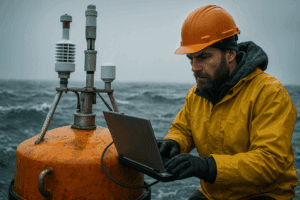Port Innovation
Port digitalization is one of four key categories of port innovation. These innovations consist of robotics, process automation, decision-making automation, and digitalization.
- Robotics encompasses the integration of automated systems.
- Process automation is processes that minimize human involvement. For example, driverless trucks, drones, and crewless ships and vessels.
- Decision-making automation is planning optimization, for example, automation of vehicle and equipment scheduling.
- Digitalization, the focus of this article, is the use of technologies for all operations. Technolgies include: IoT, Big Data, blockchain, 5G, and Artificial Intelligence.
These four innovations lead to a more efficient supply chain management. Specifically, digitalization is changing the way ports operate, turning them into Smart Ports, creating Digital Twins, and thus affecting the entire maritime and logistic supply chains.
Predict the ETA of any vessel for free!
Get an accurate prediction of the ETA of any vessel thanks to our ETA Calculator Module. It’s easy, in real-time and free. You just have to sign-up to our HUB.

What is Digitalization?
Digitalization is the idea that all data is provided to all stakeholders in real-time on one open platform to improve efficiency and accurate decision making. Digitalization leverages on digitization (transformation from physical to digital) by bringing value to company roles instead of just replacing them. For example, digitization replaces cranes with automation, but digitalization brings value to the crane operators by placing them in remote towers which makes their jobs safer and more efficient.
Digitalizing involves transforming business transactions to a single process platform that acts as an operational backbone, and it is revolutionizing the maritime industry and making Smart Port solutions possible.
What Is Port Digitalization?
Port digitalization is the digital transformation of port processes. These processes are always collecting new data, evolving, and learning. This gives stakeholders real-time situational awareness of all events going on in their ecosystem. To fully digitalize operations, all stakeholders must be on board, as it influences the entire supply chain. Although digitalization improves efficiency and effectiveness, there must be an idea of collaboration not only between stakeholders but also between ports. This transformation is a big cultural change for the maritime industry, an industry born in the 15th century.
Port digitalization is the foundation of Smart Ports and Digital Twins. Digital Twins use technologies like Big Data, IoT sensors, Artificial Intelligence, and blockchain. Although these tools and solutions can transform real-time data into accurate and more precise business decisions, the most important aspect is that the digitalization and technology used is deliverable and configurable.
Port digitalization is extremely effective for operations. Cranes and vehicles can be automated, saving time and money, real-time data can be shared, and essentially all stakeholders can know exactly what is going on during port operations. Ports can adopt automation processes, process cargo and containers at a higher speed with less error, and increase their effectiveness.
Port digitalization, in the future, can go as far as to create an interconnectedness between all maritime actors. This is a long-term solution that would connect an international network of Smart Ports which would increase transparency between shipping companies, ports, and stakeholders.
What is a Digital Twin?

A Digital Twin is a virtual representation of the real world. Therefore, a Digital Twin is a digital representation of the entire port. This includes the physical objects, processes, relationships, and behaviors between all activities and actors. With a Digital Twin, authorities can better manage assets and observe the entirety of operations. They are the foundation for the future of shipping, which is autonomous vessels. They can even visualize the current versus expected performance of their port and compare themselves to others internationally. Digital Twins take maritime data that is challenging to understand and turn it into comprehensible data that increases business efficiency.
Digital Twins can analyze how rising sea levels due to global warming will affect their operations, protect environmental zones thanks to powerful AI tools, and easily share and collaborate with global supply chain actors.
How Is Port Digitalization Affecting Operations Today?
Port digitalization is changing the container handling industry. With a growing world and economy, ships are getting larger, and more containers are being unloaded at terminal docks. Thanks to port digitalization, port quay operations are becoming safer, more efficient, more accurate, and more traceable. This fixes the past issue of terminals being unsafe due to heavy machinery, data inaccuracy, and untraceable activities.
With digitalized quay operations, there is full automation of dangerous equipment like cranes, which with technology have operators using advanced data to control them from remote towers.
Data solutions allow all port workers and authorities to see all activities that are happening in real time. Therefore, all workers may be more reactive and productive. There is better communication between employees, time saved thanks to automation, and all systems speak with each other thus improving reliability.
Port digitalization also improves overall port security. Port security officers can see all port events and port activity. For example, some ports have sulfuric acid plants. If these leak, this is dangerous to environmental and human health. If a port is not digitalized, the leak would not be detected for days. However, with a digitalized port, the leak is detected immediately. The port authorities can then notify all stakeholders that this toxic leak could affect. This is because port authorities have real-time information of all port activities giving them accurate situational awareness.
All data is connected to one operations dashboard. Users can see live traffic, alert and delays, and all incidents broken down by type. Dashboards can also show weather reports, and be connected to water, air, and noise sensors. Traffic outside of the port can even be detected, so that trucks know when to coordinate their arrival based on accurate vessel estimated time of arrival. Workers can communicate instantly, and everyone and all activities are thus connected.
Predict the ETA of any vessel for free!
Get an accurate prediction of the ETA of any vessel thanks to our ETA Calculator Module. It’s easy, in real-time and free. You just have to sign-up to our HUB.

Why Is Port Digitalization Becoming Popular?
Many ports currently operate in information silos (like TOS systems that do not communicate with each other in real-time). However, becoming a digitalized port is gaining traction now that maritime actors are witnessing the benefits.
Maritime industry actors want to improve business efficiency and realize that they must keep up with the digital world to remain competitive. As an industry that is flooded with large amounts of data, there is a lot of potential to transform the entire maritime supply chain.
Ports are a major node in this supply chain, and so for the supply chain to go digital, a port must become a Smart Port.
There is also an idea of interconnectedness between Smart Ports. Much like air traffic control can witness all airline activity, aspiring Smart Ports wish the same thing for the maritime industry. This way ports may be connected with each other to understand global activities in real-time.
Once ports take the step toward digitalization, many other actors associated with their operations will follow.
Key Challenges for Port Digitalization
As with any change, there remain challenges to adapt to a new system.
Ports are not all the same size and do not all operate at the same capacity. Therefore, small ports may adapt a different solution than a large international port.
As with any innovative technology, ports must protect their data, learn to co-operate with supply chain parties, and learn to adapt to changes.
For ports to go fully digital, the entire supply chain must collaborate and work together. Standards must be implemented throughout companies, and technologies must be fully accepted and integrated.
Companies like Sinay encourage maritime actors to integrate digital solutions into their business activities to stay in touch with modern trends for success. With our Sinay Hub, we give maritime actors a holistic 360-degree view of their activities, and we help them adapt to new technologies.
Frequently Asked Questions About: PORT DIGITALIZATION
Maritime digitalization is the digitization of maritime processes. With a growing world and economy, ships are getting larger, and more containers are being unloaded at terminal docks. Thanks to maritime digitalization, port quay operations are becoming safer, more efficient, more accurate, and more traceable. This fixes the past issue of terminals being unsafe due to heavy machinery, data inaccuracy, and untraceable activities.
Digitalization is the idea that all data is provided to all stakeholders in real-time on one open platform to improve efficiency and accurate decision making. Digitalization leverages on digitization (transformation from physical to digital) by bringing value to company roles instead of just replacing them. For example, digitization replaces cranes with automation, but digitalization brings value to the crane operators by placing them in remote towers which makes their jobs safer and more efficient.


